Broken Arrow, OK Pollen and Allergy Report for Summer 2023
Pollen Allergy Trends in Broken Arrow, OK
When is pollen lowest in Broken Arrow, OK?

February
Lowest month total PPM
Avg. PPM
When is pollen highest in Broken Arrow, OK?

March
Highest month total PPM
Avg. PPM
How does pollen in Broken Arrow, OK compare to Oklahoma?
Broken Arrow has a higher average PPM than the state of Oklahoma.
Broken Arrow yearly avg PPM:
Oklahoma yearly avg PPM:
How does pollen in Broken Arrow, OK compare to the USA?
Broken Arrow has a higher average PPM than the USA.
Broken Arrow yearly avg PPM:
USA yearly avg PPM:
Is pollen worse this year in Broken Arrow, OK?
Spring 2023 was worse than spring 2022.
Spring 2023 PPM:
Spring 2022 PPM:
Average PPM in Broken Arrow, OK
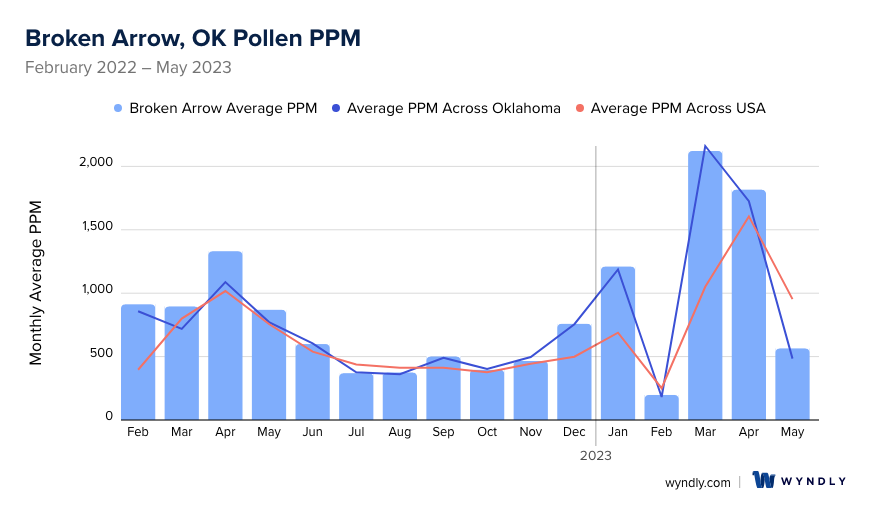
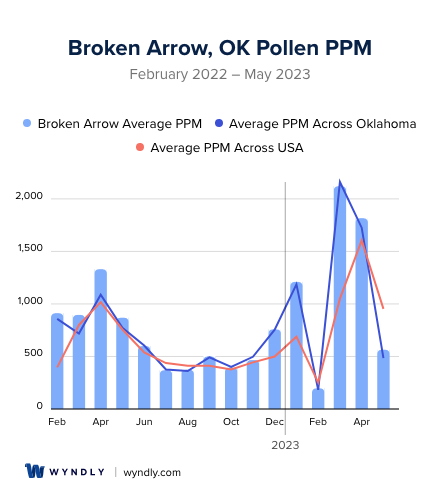
Broken Arrow, OK Pollen and Allergy Breakdown by Month
Grass
When is grass pollen highest in Broken Arrow, OK?
February has the highest grass pollen in Broken Arrow, OK with an average PPM of
When is grass pollen lowest in Broken Arrow, OK?
December has the lowest grass pollen in Broken Arrow, OK with an average PPM of
Tree
When is tree pollen highest in Broken Arrow, OK?
March has the highest tree pollen in Broken Arrow, OK with an average PPM of
When is tree pollen lowest in Broken Arrow, OK?
July has the lowest tree pollen in Broken Arrow, OK with an average PPM of
Weed
When is weed pollen highest in Broken Arrow, OK?
April has the highest weed pollen in Broken Arrow, OK with an average PPM of
When is weed pollen lowest in Broken Arrow, OK?
February has the lowest weed pollen in Broken Arrow, OK with an average PPM of
Broken Arrow, OK Pollen Monthly Breakdown by Pollen Type
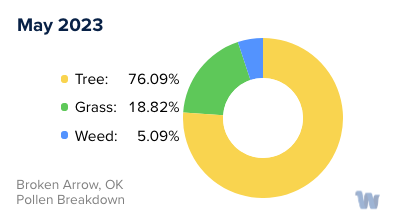
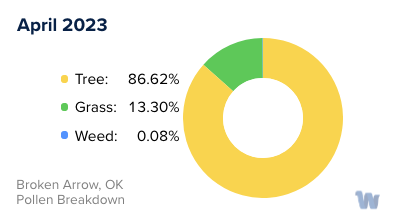
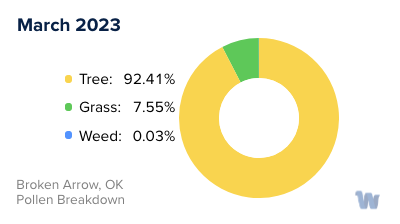
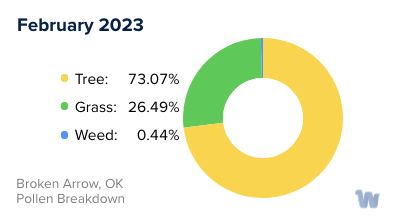
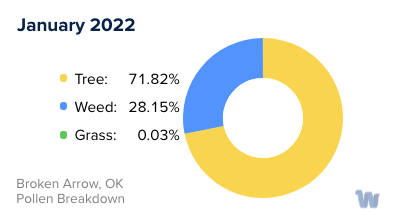
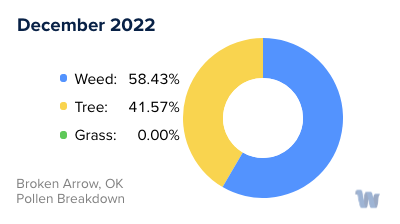
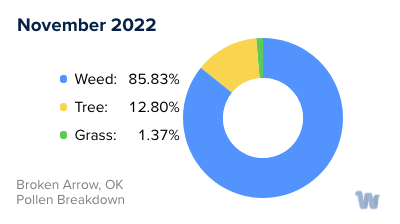
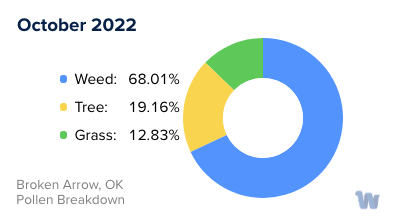
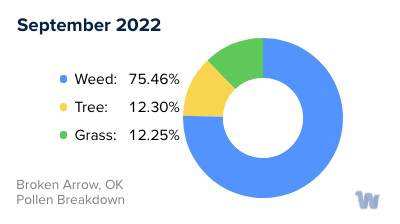
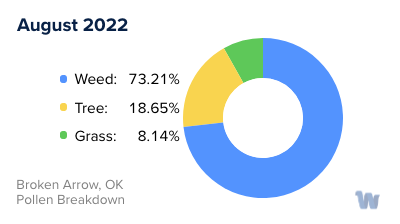

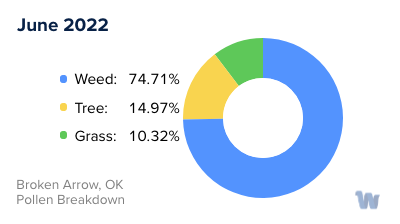
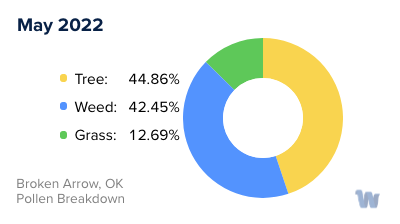
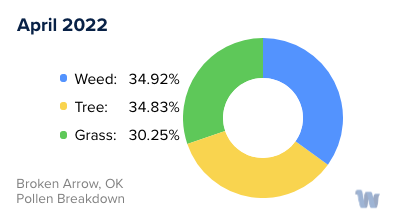
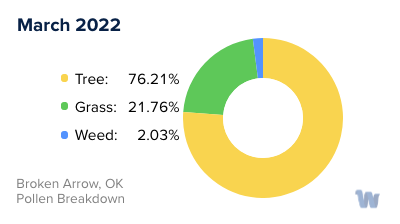
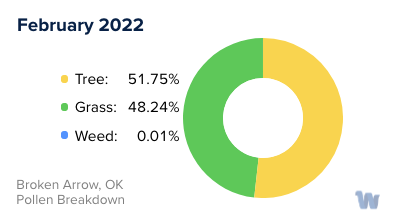
Pollen and Hay Fever in Broken Arrow, OK
Seasonal allergies are a common issue for residents of Broken Arrow, Oklahoma, primarily triggered by various types of pollen. The state's dry and windy conditions facilitate the easy spread of pollen, making it hard for those with seasonal allergies to avoid their triggers. Three primary types of pollen contribute to these allergies: grasses, trees, and weeds.
In Broken Arrow, Oklahoma, residents grapple with pollen allergies that are primarily triggered by grasses, trees, and weeds. The main offenders include tree pollen, grass pollen, and ragweed pollen. Additionally, the area has a variety of trees such as Oak, Mulberry, and Elm, which contribute to the pollen count.
Seasonal allergies in Oklahoma can start as early as February due to the state's milder winters. The dry and windy conditions of Oklahoma facilitate the travel of pollen across the state, exacerbating the allergy situation. Most winter and spring allergies are the result of tree pollen, making these seasons particularly challenging for allergy sufferers.
As we move into summer, grass pollen becomes the primary cause of pollen allergies. This shift means that people who are sensitive to grass pollen might experience heightened allergy symptoms during this time.
In the fall, allergies are likely caused by pollen from weeds, with ragweed being a common allergen. While allergy season takes a brief break during the colder months of winter, the respite is often short-lived due to the short and mild winters in Oklahoma.
The peak of the allergy season typically happens between March and June. During these months, individuals sensitive to pollen might want to limit their time outdoors or prefer to venture out in the evening when pollen counts tend to be lower.
While this description might sound daunting, knowing what to expect from each season can help individuals better prepare for and manage their pollen allergies. Remember, each person's experience with pollen allergies is unique and can be influenced by various factors, including the specific types of pollen they are sensitive to and their overall health status.

